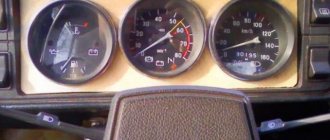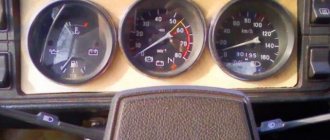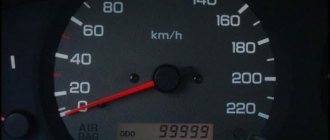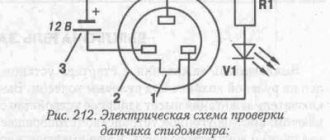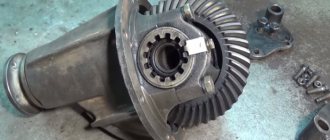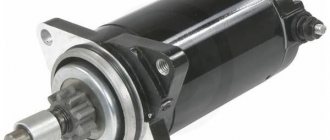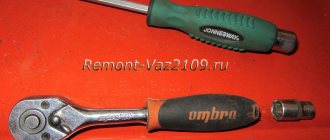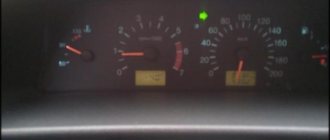03/04/2022 10,760 VAZ 2107
Author: Ivan Baranov
The driver can learn about the main operating parameters of the vehicle thanks to the dashboard. This device is equipped with basic sensors and indicators that indicate the operation of certain devices. One such device is the tachometer. For what reasons does the tachometer on a VAZ 2107 carburetor not work and how to replace the device - detailed instructions are described below.
[Hide]
Design and purpose of the tachometer
The purpose of the VAZ tachometer is to visualize the readings of the crankshaft. The device shows how fast the crankshaft rotates per minute, these readings are also called engine speed. Structurally, the VAZ 2107 tachometer is a milliammeter connected in one housing to an electronic part; these elements are installed on a printed circuit board.
As for the principle of operation, it consists in measuring the frequency of pulse transmission in the primary circuit of the engine ignition system. With the power unit operating, during one revolution of the camshaft, the contacts on the breaker should close and open 4 times. Accordingly, with one revolution, 4 voltage and current pulses are formed in the electrical circuit. As the crankshaft speed increases, the pulse transmission frequency also increases, which, in turn, affects the deflection of the instrument needle.
Tachometer malfunctions
The VAZ 2107 can have two types of engines: carburetor and injection. The electrical circuit for connecting tachometers in these cars is different from each other, and they are not interchangeable. Therefore, troubleshooting related to tachometer failure will differ depending on the engine type.
- On a carburetor engine, three wires come from the tachometer. Two wires are the power (plus and minus), and the third is connected to terminal K of the ignition coil. In order to find out what caused the failure, you need to get to the back of the instrument cluster and disconnect the terminals from the block that goes to the tachometer. Next, you will need three wires to connect the tachometer directly to the battery (plus and minus) and to the ignition coil (terminal K). You start the engine, and if under such conditions the tachometer does not work, then the problem will have to be looked for either in the ignition system or in the tachometer itself, and if the tachometer starts working, then the fault lies in the wiring that goes to the tachometer.
- On the injection engine of a VAZ 2107 car, four wires go to the tachometer. Two wires are power (plus comes from the ignition switch, minus to the vehicle ground), the third wire goes to the input of the electronic control unit, and the fourth is connected to the crankshaft position sensor. The best way to determine malfunctions in the tachometer in this case is to carry out appropriate diagnostics. Then, using the error codes, you find out the reason for the failure. Without diagnostics, you can only check the condition of the contacts in the blocks included in the electrical circuit of the tachometer and, by replacing the crankshaft position sensor with a known good one, check its functionality.
- The tachometer may malfunction if the insulation of high-voltage wires is broken or the ignition coil is faulty. In this case, interruptions in engine operation and “floating” speed are also possible. In addition to the wires and coil, it is necessary to check the condition and adjustment of the breaker contact and the capacitance of the capacitor on it (for carburetor sevens). Faulty wires and, as a result, unstable engine operation, cause the tachometer to “jump” on injection VAZ models.
- Fuel system malfunction. The cause of interruptions in engine operation and jumps in the tachometer needle can be either low-quality fuel or problems in the injection system. On carburetor models, disassemble the carburetor and clean the jets. Most often, a “jumping” tachometer is the result of a clogged idle jet. The VAZ 2107 tachometer (injector) can “jump” if there are problems in the injection system. In this case, it is necessary to flush the injectors. To check and clean the injection system, you need a special stand and equipment. It is better to entrust such work to service station specialists.
- Malfunction of the gas distribution mechanism. When the tachometer needle begins to “jump” at high speeds, the problem may be associated with a malfunctioning gas distribution mechanism. In this case, it is necessary to check the tension of the timing belt connecting the crankshaft to the camshaft.
Replacing the tachometer yourself
In conclusion, let us remind you that your vehicle is always on the move, service it on time, listen to any bells that can be easily eliminated at the stage of the problem. This is the only way you can save your money and precious time.
Ignition system
As mentioned earlier, the ignition system of the VAZ 2107 car and the tachometer needle are interconnected; they cannot exist without each other. And if the arrow twitches, and all the above tips did not help, you should pay attention to the condition of the ignition elements. First of all, inspect the wires for damage or lack of contacts.
It is quite possible that there is a break inside the device itself. The photo shows a wiring diagram, study it to get an idea of where the wires go and where they come from. If the power system has a carburetor and a classic ignition system is installed, then it is possible that a breakdown of the capacitor installed in the lower part of the distributor has occurred.
In most cases, the needle jumps if there is a malfunction in the ignition system. It is quite possible that the Hall sensor is malfunctioning. But in this case, unstable engine operation will be felt. If you have an injector, then you should check the condition of the engine speed sensor and all connecting wires.
Very often failures occur after the tachometer has been disassembled or replaced. If you have performed such actions, then you need to carefully check whether the device is installed correctly, is the connection made in accordance with the diagram, is the arrow at zero when the engine is stopped? It is worth noting that there is a toggle switch on the back of the device; it is designed to set the needle to zero.
But there are times when at idle the needle behaves quite well. But at speed, when the speedometer passes the mark of 80 or 100 km/h, the needle begins to twitch strongly. In this case, it is even possible that misfires may occur. This is a sign that there is a breakdown in the ignition switch and it needs to be replaced urgently. That's all that can be said about the device designed to measure crankshaft rotation speed.
Abstract on the topic “Types of instrument clusters 2107”)))))
Let's look at the general diagram of devices 151.3801
Until 1988, instrument cluster 15.3801 was used
You can find instruments for export cars with a different speedometer scale (with miles)
Tidy 35.3801 for Gazelle and Sable cars is very similar to it
There is a device for UAZ Patriot cars with a slightly different connection
In short, when replacing devices, you can install the wrong one, and something will not show. For injection 2107s of the last years of production there is a tuned electronic device Gamma GF 607 with a trip computer and a astronomical price
The device 110.3801 for UAZ-3162 is not at all similar to the devices 2107
Kind of a conclusion. Although the devices are outdated and prone to breaking, they are still quite informative. At that time, the VAZ-2107 was one of the cars stuffed with all sorts of sensors. At the moment, 2107 devices are subject to collective farm damage due to the “unfashionable” weak and green backlight in our time. People install ugly scales with transparent numbers, glue diode strips inside, not noticing the factory beauty of one of the few instrument clusters at that time (the instruments are combined into one unit and have curved glass to eliminate glare), which appeared in the 80s.
Electrical diagram of VAZ 21074
In VAZ 21074 cars, electrical energy is delivered to consumers using a single-wire circuit: the “positive” terminal of each electrical device is powered from a source, the “negative” terminal is connected to “ground,” i.e., connected to the vehicle body. This solution simplifies the repair of electrical equipment and slows down the corrosion process. All electrical appliances of the car are powered from the battery (with the engine off) or the generator (with the engine running).
The wiring diagram of the VAZ 21074 injector contains an ECM, an electric fuel pump, injectors, and engine control sensors
Wiring diagram VAZ 21074 injector
The injection versions of the “Seven” released from the factory assembly line have the following indices:
- LADA 2107–20 - in accordance with the Euro-2 standard;
- LADA 2107–71 - for the Chinese market;
- LADA-21074–20 (Euro-2);
- LADA-21074–30 (Euro-3).
The injection modifications of the VAZ 2107 and VAZ 21074 use an ECM (electronic engine control system), an electric fuel pump, injectors, control sensors and monitoring engine parameters. As a result, there was a need for additional under-hood and interior wiring. In addition, the VAZ 2107 and VAZ 21074 are equipped with an additional relay and fuse box located under the glove compartment. The additional unit is supplied with wiring that supplies:
- fuses: main relay power circuits;
- controller constant power supply circuits;
- electric fuel pump relay circuits;
- The main thing;
Additional fuse and relay block VAZ 2107 injector located under the glove compartment
Providing electricity
The G7 is responsible for providing consumers with electricity:
- Battery voltage 12 V, capacity 55 Ah;
- generator type G-222 or 37.3701;
- voltage regulator Ya112V, which automatically maintains the voltage within 13.6–14.7 V.
Diagram of the power supply system for the VAZ 21074 injector includes a generator, battery and voltage regulator
Engine starting
The starting system in the VAZ 21074 is a starter and ignition switch powered from the battery. There are two relays in the starter circuit:
- auxiliary, which supplies power to the starter terminals;
- retractor, due to which the starter shaft engages with the flywheel.
The starting system in the VAZ 21074 is a battery-powered starter with a relay and an ignition switch.
Ignition system
In early versions of the seventh VAZ model, a contact ignition system was used, which included:
- ignition coil;
- distributor with contact breaker;
- spark plug;
- high voltage wiring.
The VAZ 21074 contact ignition system consists of a coil, distributor, spark plugs and high-voltage wires
In 1989, the so-called contactless ignition system appeared, the circuit of which included:
- Spark plug.
- Distributor.
- Screen.
- Hall Sensor.
- Electronic switch.
- Ignition coil.
- Mounting block.
- Relay block.
- Key and ignition lock.
In 1989, a contactless ignition system appeared, to the circuit of which a Hall sensor and an electronic switch were added
“Sevens” with injection engines use a more modern ignition circuit. The operation of this circuit is based on the fact that signals from the sensors are sent to the ECU (electronic control unit), which, based on the received data, generates electrical impulses and transmits them to a special module. After this, the voltage increases to the required value and is supplied to the spark plugs through high-voltage cables.
In injection "sevens" the operation of the ignition system is controlled by the electronic control unit of the ECU
Outdoor Lighting
The external lighting system includes:
- Block headlights with dimensions.
- Illumination of the engine compartment.
- Mounting block.
- Glove compartment lighting.
- Instrument lighting switch.
- Rear lights with dimensions.
- Illuminated numbers.
- Exterior lamp switch.
- External lighting indicator lamp (in the speedometer).
- Ignition.
The VAZ 21074 external lighting connection diagram will help in troubleshooting headlights and tail lights
Auxiliary equipment
Auxiliary or additional electrical equipment of the VAZ 21074 includes:
- electric motors: windshield washer;
- windshield wiper;
- heater fan;
- radiator cooling fan;
The connection diagram for windshield wipers uses:
- Gearmotors.
- ED headlight washer.
- Mounting block.
- Egnition lock.
- Washer switch.
Windshield wiper motors drive a trapezoid that moves the wipers across the windshield
VAZ 2107 tachometer does not work
: 08/27/2018 When choosing a future profession or wanting to change their field of activity, thoughtful people study the market, assessing which ones are the most in demand, highly paid and prestigious.
After all, the right choice can significantly help in your career, which means it will allow you to provide yourself and your loved ones with a decent life, go here Honda.
Another thing is that the most prestigious professions require extraordinary qualities, hard work, perseverance and talent, but this game is worth the candle. Selecting a charger. Tips for use
In Russia, these professions began to appear on similar lists not so long ago, but over the past few years they have only been moving forward, and have now reached the highest position. Programmers of all stripes and types, designers, developers, web analysts, SEO specialists - this list can be continued for a very long time. BSZ problem with tachometer
One thing is clear - specialties related to computers and the Internet today are really in demand and quite highly paid. The lower bar may not impress beginners, but by achieving success in your chosen profession, you can increase your income almost indefinitely. Tachometer connection
articles: Top management Lawyers Logistics Medicine Accountant Auditor Information technology Sales promotion Management Purchasing manager Sales manager Beauty industry Creative activities Conclusion
It is almost impossible to identify areas of activity in which women cannot work. The fair sex realizes itself with equal success in management, economics, IT and oil production. At the same time, there are a number of profitable professions for girls related to the beauty industry, the service sector or the same accounting department, where there are very few or no men.
Hello everyone, today I would like to talk about the possible reasons why the tachometer on a VAZ 2107 does not work. The tachometer on a car plays a very important role and therefore cannot be delayed and urgently repaired or, in extreme cases, replaced.
So, to begin with, you must understand that the VAZ 2107 has two types of engines, namely carburetor and injection. Accordingly, the tachometer connection diagram on these machines is different. Well, let's first look at the carburetor seven.
Tachometer on a VAZ 2107 carburetor engine
On the carburetor seven, three wires come out from the tachometer. Two wires are plus and minus (power) and the third wire is connected to the ignition coil. If the tachometer is out of order, then in order to understand the reason you need to get to the terminals that go to the tachometer and disconnect it.
THIS IS INTERESTING: Remove the VAZ 2114 heater fan
You will need three wires to connect the tachometer directly to the battery plus and minus, as well as to the ignition coil, terminal K. Then you need to start the engine and see if the tachometer does not work, then the fault must be looked for in the ignition system or in the tachometer itself.
But, if the tachometer works, then the problem is in the wiring that goes to the tachometer.
Tachometer on a VAZ 2107 injection engine
Above we looked at tachometer malfunctions on the carburetor seven, now it’s time for the injection one. On the injection seven, there are no longer three, but four wires going to the tachometer. The two wires are plus and minus, the plus comes from the ignition switch, and the minus goes to the ground of the car. The third wire goes to the input of the control unit. The fourth is connected to the crankshaft position sensor. The best option to determine the malfunction of the tachometer on the injection seven is diagnostics. In this case, using the error codes, you can determine the reason why the tachometer does not work. Well, without diagnostics you can only check the contacts on the blocks. It also happens that the tachometer needle starts to twitch, this is mainly due to the fact that the owners change the standard wiring to a more modern one. And given the fact that the resistance is different, such a nuisance appears. Well, that’s all for today, we have looked at the main reasons for the failure of the tachometer on the VAZ 2107 for now. January 21, 2022 753
see also
Comments 79
A question arose: if I install the device, which was installed on the 2107 2004 before 1988, will the oil pressure indicator work? And what other difficulties might you encounter?
The devices have slightly different pinouts. It will be necessary to rearrange some wires. If the car is late, the tachometer may not work, you may have to rearrange it. In order for the oil pressure indicator to work, you will need to install an additional sensor and run a wire to it.
I read that the tachometer is generally installed on the Volga so that it is smooth, but I can’t find any information about this yet. That is, while it turns out that simply tossing chips will not work, the tidy will not work?
It will work except for the oil gauge and possibly the tachometer. And instead of the choke lamp there will be a red brake lamp.
According to the pink-blue scheme, this is a plus; it goes into block sh7 and comes out with sh5? Got it right? If I take a minus at the output and connect to the pink-blue one as a plus, then there will be a plus at the output and connect it to the device, will the sensor work?
You can simply disconnect the minus from the sensor and throw a plus there (orange from the EPHH block, for example). Then there will be a plus on pink and blue.
I found a diagram on the Internet. Do you think it’s correct?
Hello. I want to install a VAZ 2114 or 2110 tidy on a VAZ 2107 carb. Question: to show the brake fluid level on the dash, how should the connection be made? After all, there is a minus at the output and a plus should be supplied to the tidy.
I didn’t manage to read all the comments, maybe it was. I have an 87-year-old English VAZ 2107, there was no generator charging light in the dash, although there was a symbol in the dash, there wasn’t even a wire in the chip for the light and there were no wires in the mounting block for the charge light.
Is it possible to integrate such a device on a VAZ 2107?
You need to look at what sensors are used on cars with such a tidy. If the sensors are the same as on the VAZ, or similar in parameters, then it may be suitable. You need to look for information on the UAZovodov website, maybe someone installed this instead of the standard one, similar to 2107.
Is the instrument panel from Simbir the right size for a VAZ 2107?
Thank you. I found several points that I had not delved into before. By the way, I also messed around with the tidy
